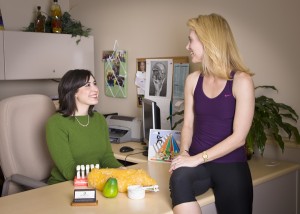 Food is a necessary evil for your members. It can be an addiction or an indulgent treat, but in reality, its fuel for the body. Members can’t cut themselves off from food, but they can learn about proper nutrition — knowledge that should come from their club.
Food is a necessary evil for your members. It can be an addiction or an indulgent treat, but in reality, its fuel for the body. Members can’t cut themselves off from food, but they can learn about proper nutrition — knowledge that should come from their club.
“Clubs need to make an investment in nutrition,” said Judi Samuels, a certified nutrition and wellness consultant for Sport&Health. “I don’t think you can talk about fitness without nutrition.”
Clubs have a great opportunity to be seen as an expert on all things health and wellness if they position themselves properly. Invest in nutrition and hire someone to guide your members nutritionally, or set up a partnership outside of the gym. Your members will see the best results when combining proper nutrition and exercise. For this kind of education and attention needed, clubs can’t rely solely on personal trainers to field all nutrition questions.
What Clubs Can Offer
It may be difficult sometimes to get members to see the benefit of proper nutrition and nutrition counseling. Melissa Hawthorne, a registered and licensed dietitian with a Master of Science in nutrition at The Houstonian Clubs and Spas, said she finds success in using scientific research and success stories of members to highlight achievements that utilized nutrition.
Hawthorne provides members at The Houstonian with a menu of options to choose from regarding nutritional assistance. “Primarily, I put together personalized meal plans for members and meet for one-on-one consultations with them.They keep a food log and then we personalize a meal plan instead of giving them a blatant 1,200-calorie diet plan for them to follow. I don’t think that works well for most people.” Part of the process is helping members rearrange their nutrition plan to fit their lifestyle. According to Hawthorne, this helps members best achieve their goals. There are different packages available for members to purchase based on the number of sessions that they desire.
Additionally, Hawthorne offers monthly nutrition seminars and grocery store tours, where she takes members to the various grocery stores in town and teaches them how to shop nutritionally — both are for a small fee. She also works with families, giving kitchen recommendations, helping to overhaul kitchens to make them healthier, teach cooking lessons in the home and will make family cookbooks with about two weeks worth of meals for moms stuck in a cooking rut.
Members can participate in a club program called Resolution Shape Up, that incorporates cardio, strength training and nutrition, and members meet with both personal trainers and Hawthorne. They can also participate in “Dine Out with the Dietitian” where Hawthorne works with surrounding restaurants and talks with chefs about how their meals are prepared. Members are presented the information and then the group orders out together at the restaurant. At Sport&Health, Samuels has partnered with her local Trader Joe’s, a whole foods store, to provide products for food demonstrations at her club — both are good opportunities to get local communities involved.
Internal Relationships
Samuels has a close relationship with the trainers at her club and their symbiotic relationship works well for the club and its members. “There’s a core group of us that all started out together here, and the trainers are very good about referring for nutrition. They help drive the message, if you’re not changing how you eat, then you’re wasting time,” she said. At Sport&Health, Samuels has a nutrition corner. She displays fliers and tips for members and a section in particular with a question and answer board, “Ask the Nutritionist.” In conjunction with the personal training, Samuels created a presentation for members, “What Trainers Want You to Know,” about how to properly fuel the body for workouts. “My hope is that people will be able to eventually attach nutrition counseling to every personal training session in the future.”

Hawthorne assisted The Houstonian Café’s chef in developing nutritional information for the café items. The café offers members snacks called “Lite Bites” that come in different caloric intakes to fit a variety of needs. At Sport&Health while Samuels does not have a café, she has worked toward offering only healthy snack options in the vending machines at her club.
Supplements are another way to offer a source of nutrition to members. Aaron Callister, a multiple club owner with Snap Fitness, has trainers direct members on proper supplementation when needed, based on personal assessments they’ve done with members. “[Members’] purchases of supplements can vary to local vendors, trainers who distribute for major retailers or wholesale websites,” Callister said.
If clubs are selling supplements to members, Iris Harrison, the vice president of operations for Navacorp Inc., makers of Kickbutt Amped Energy Ballz™, suggested promoting them during the orientation process. “Have a discussion with members. Ask them questions about what they tried previously and what has worked for them in the past. Once you know a little bit more about them then you can showcase what you offer.”
Members today are wising up, according to Brad Kloss, the owner of Pro Claim Nutrition, maker of FitPro Milk. “Today’s consumer wants to know the source of their food and supplements,” Kloss said. “Safety, efficacy and convenience are important to the consumer when choosing a product.” Dan Young, the president of Performance Food Centers, echoes those sentiments — members are starting to realize the importance of making healthy food choices. “They accept that they should eat well, but often times they do not know how to get started,” Young explained. “They want to consume health products to meet their individual performance goals, but they have many questions along the way. Health club owners have a great opportunity to lead the market as educators on nutrition,” he said.
Juice bars can offer members a variety of options that meet their needs. “Successful juice bars offer their members nutrient dense shakes and snacks, made with only whole-food ingredients that align with a variety of specific performance goals. Really successful juice bars go a step further by educating their members on what shake they should buy and why,” Young said. He thinks most clubs should be able to sustain a juice bar with a few tweaks to maybe product offerings, menu board selection, mode of educating members, layout efficiency and process improvements.
Juice bars add value to a club as well. “With increasing competition among health club facilities today, there is an ever-present need to expand a club’s amenities in order to retain customers and bring in new ones,” said Stephanie Suddarth, the president of City Blends, Ltd. “The addition of a smoothie café in your facility will offer your members a vital social center that will allow them to make connections and develop relationships with other members and staff.”
The bottom line: members need guidance when it comes to nutrition. Clubs that position themselves as experts and show they are willing to help members educate themselves on a healthy diet will be more successful and have more members reaching their goals. Hawthorne suggested starting small, having an “on-call” dietitian who could possibly scope out the needs of the club. She said, “It’s a building process, we didn’t get here overnight either.” -CS
By Ali Cicerchi






Comments 1